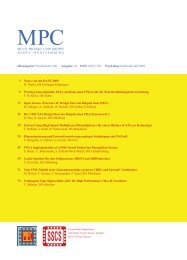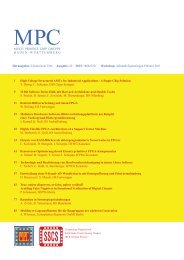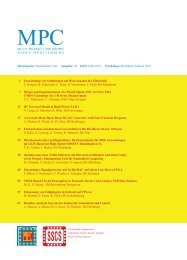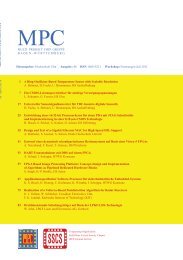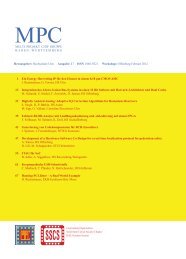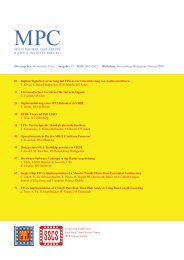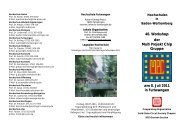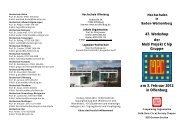[Geben Sie hier die Überschrift ein] - MPC
[Geben Sie hier die Überschrift ein] - MPC
[Geben Sie hier die Überschrift ein] - MPC
- TAGS
- mpc.belwue.de
Sie wollen auch ein ePaper? Erhöhen Sie die Reichweite Ihrer Titel.
YUMPU macht aus Druck-PDFs automatisch weboptimierte ePaper, die Google liebt.
<strong>MPC</strong>-WORKSHOP JULI 2012<br />
Realization of an RFID Front End IC for ISO 15693<br />
Standard in UMC CMOS 0.18 µm Technology<br />
Mayukh Bhattacharyya, Tobias Volk, Andreas Kreker, Benjamin Dusch, Dirk Jansen<br />
Abstract—The RFID Front End manages communication<br />
and protocol according to the requirements<br />
of the ISO 15693 standard. It is developed<br />
for passive as well as semi-passive applications and<br />
interfaces to standard microprocessors, which can<br />
be programmed to capture data or execute commands<br />
in a general manner. The current consumption<br />
of the front end is below 50 µA, making it<br />
suitable for low power applications. This paper<br />
covers the analog part only. The reader generates<br />
an ASK-modulated signal, which is demodulated<br />
and provided as a digital signal. The 13.56 MHz<br />
clock is recovered and a signal, which detects the<br />
existence of RF field, is used. For the back channel,<br />
classical load modulation is implemented. There<br />
are further elements for passive applications integrated,<br />
a low drop out regulator LDO with adjustable<br />
output voltage and a reference voltage source<br />
with a bandgap circuit. This makes the front end<br />
IC suitable for energy harvesting sensor applications.<br />
Index Terms—RFID (Radio frequency identification<br />
device), RF–field passive system, energy harvesting,<br />
bandgap reference, low drop out regulator,<br />
ASK demodulator.<br />
I. INTRODUCTION<br />
RFID technology is regarded as one of the evolutionary<br />
technology of the 21st century. It was initially<br />
used as a replacement for the existing barcode systems,<br />
over the years RFID has evolved as one of the<br />
key technologies for device identification. In addition<br />
to its original intention, the technology of bidirectional<br />
data communication available with RFID can again be<br />
used for ultra-low power or even passive micro sensor<br />
systems. There are applications in transportation,<br />
manufacturing, biomedical [1], environmental management,<br />
safety and security systems. The advantage<br />
of using an established standard, with low cost reader<br />
systems available in the market or even integrated into<br />
the newest mobile phones makes short range telemetry<br />
Mayukh Bhattacharyya, mayukh.bhattacharyya@hs-offenburg.de, Tobias<br />
Volk, tobias.volk@hs-offenburg.de, Andreas Kreker, andreas.kreker @hsoffenburg.de,<br />
Benjamin Dusch, benjamin.dusch @hs-offenburg.de, and Dirk<br />
Jansen, d.jansen@hs-offenburg.de, are with University of Applied Sciences-<br />
Offenburg, Badstrasse 24, 77652 Offenburg.<br />
Figure 1: Inductive coupling for an RFID reader transponder<br />
system.<br />
Figure 2: Front end with external devices.<br />
cheap and ubiquitous available.<br />
A typical RFID system consists of a reader and a<br />
transponder; the reader may be a smart phone or a host<br />
computer, connected to a network [2]. The tag consists<br />
of the front end (FE), which has an analog part and a<br />
digital part as well as a back end, which may be a data<br />
capturing system like a microprocessor, coupled with<br />
a sensor and external memory. In a fully developed<br />
tag, all these units will be integrated into one IC with<br />
only the sensors separated, making a so called “smart<br />
tag”, running optimally by harvesting the supply energy<br />
from the RF field.<br />
Semi-active sensor tags contain an own supply,<br />
mostly a battery, because they have to be active without<br />
the connection to the reader, i.e. for collecting data<br />
at predefined intervals. These kinds of sensors have<br />
again several applications [3], the RFID interface is<br />
only used for convenient and extreme low power read<br />
out. The RFID reader/ transponder system can be<br />
typically defined as a loosely coupled transformer,<br />
where the antenna of the RFID reader acts as the primary<br />
and the antenna of the transponder acts as the<br />
secondary winding as shown in Figure 1. A typical<br />
RFID front end with external devices is shown in<br />
figure 2.<br />
25


![[Geben Sie hier die Überschrift ein] - MPC](https://img.yumpu.com/8654082/28/500x640/geben-sie-hier-die-uberschrift-ein-mpc.jpg)
